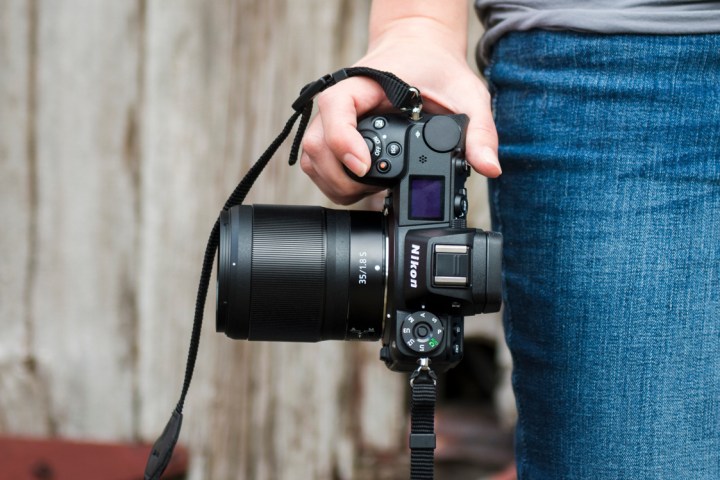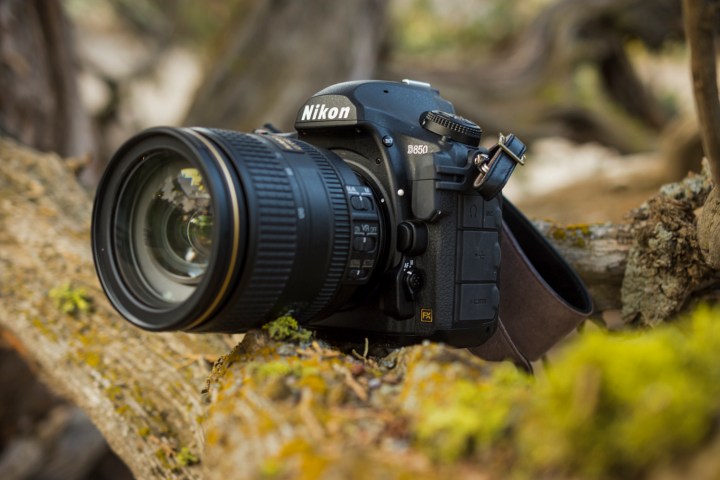
Nikon finally stepped into professional mirrorless cameras, and its flagship Z7 isn’t just a slimmed-down virsion of the D850 DLSR, even if the two share many similar specifications. Both feature a 45.7-megapixel full-frame sensor, 4K video, and an almost identical price point. But the Nikon Z7 adds in-body image stabilization and a processor that’s even faster than the one inside the D850. So which camera is better? The choice is a tough one.
Nikon Z7 vs Nikon D850: The specs
| Nikon Z7 | Nikon D850 | |
| Sensor | 45.7 megapixel full-frame CMOS without optical low pass filter | 45.7 megapixel full-frame CMOS without optical low pass filter |
| Burst Speed | 9 fps in extended mode or 5.5 fps with live view | 7 fps (9 fps with optional battery pack) |
| Shutter Speed | 30 sec. to 1/8000, bulb | 30 sec. to 1/8000, bulb |
| ISO | 64 – 25,600 (32 – 102,400 extended) | 64 – 25,600 (32 – 102,400 extended) |
| Autofocus | 493-point hybrid phase-detection contrast AF | 153 dynamic area phase-dtection points (contrast detection AF in Live View) |
| Low Light AF | -1 to +19 EV (-4 to +19 in low light AF mode) | -4 to +20 EV |
| Flash Sync | 1/200 | 1/250 |
| Image Stabilization | 5-axis sensor shift | None (available in some lenses) |
| Video | 4K at 30 fps, 1080p at 120 fps | 4K at 30 fps, 1080p up to 5x slow mo |
| Viewfinder | 0.5-inch, 3.69-million dot EVF, 100-percent coverage | Optical, 100-percent coverage |
| LCD | 3.2 inch, 2.10 million dot tilting touchscreen | 3.2 inch 2.359 million dot tilting touchscreen |
| Media Slots | Single XQD card slot | One XQD, one SD (UHS-II compliant) slot |
| Battery | 330 shots | 1,840 |
| Dimensions (WxHxD) | 5.3 x 4 x 2.7 inches | 5.8 x 4.9 x 3.1 |
| Weight | 1.29 lbs. (body only) | 2.02 pounds (body only) |
| Price | $3,400 | $3,300 |
| Read more | Nikon Z7 Review | Nikon D850 Review |
| Buy Now |
Size
The move to mirrorless shaves more than a half pound, putting the Nikon Z7 at a weight that’s comfortable for longer shoots. Smaller isn’t always better, and thankfully Nikon included a DSLR-sized grip on the Z7 so you don’t sacrifice ergonomics. The viewfinder also juts out from the back of the camera, helping to prevent your nose from making contact with the touchscreen. This means you don’t save a huge amount of space in the camera bag over the D850, but the Z7 is still noticeably more compact.
The winner in the size category, of course, isn’t a surprise — but it’s nice to note that the Z7 isn’t so small that it’s uncomfortable to grip.
Winner: Nikon Z7
Controls
While the Z7 is smaller, the Nikon D850 has more room for physical controls, and — a sticking point for many pros — dual media card slots. The D850 uses a control layout that is very familiar for anyone who has used a Nikon DSLR, with plenty direct-access control. Several of the D850’s buttons can also be illuminated for working in the dark.
The Z7 has a surprising number of similarities with the D850 despite the smaller profile. Both have top screens, dual control wheels, joysticks, tilting touchscreens and many buttons in common, along with robust weather sealing. The Z7 ditches the drive mode dial and shortuct button cluster found on the D850 in favor of a traditional exposure mode dial. The Z7 maintains two customizable buttons near the lens mount. Even with the added options, the Z7 is still missing a few physical controls (which ones depends on what’s assigned to those front two buttons). While the design isn’t a reason not to choose the Z7, the D850 just has more space for a more robust control scheme and those dual card slots.
The Z7 does have another design feature that the D850 doesn’t — an electronic viewfinder, which unlike its optical sibling, displays an accurate exposure and depth of field, along with tools like focus peaking.
Winner: Nikon D850
Image Quality
Even placing images side-by-side, its tough to tell which image came from the D850 and which was shot on the new Z7 — the image quality is almost, but not quite identical.
While the specifications for the sensors look identical, Nikon redesigned the sensor for the Z7. The biggest change, however, is the updated processor — we noticed slightly less noise on the images from the Z7 shot at the same ISO. While a close inspection side-by-side showed the Z7 with slightly better noise reduction, both cameras had excellent color, detail, and sharpness.
Thanks to internal stabilization, the Z7 can also shoot at much slower shutter speeds, which can allow for lower ISO settings to be used, thus improving quality. This will be situation dependent — you can’t use a slow shutter to shoot a fast moving subject, for example — but it does give the Z7 another edge.
Winner: Nikon Z7 (by a hair)
Autofocus
Early mirrorless cameras lagged well behind DSLRs in autofocus performance and while many have caught up, autofocus performance is still a top concern for photographers considering the switch from DSLR to mirrorless. And in most lighting scenarios, there’s nothing to worry about. In good lighting, autofocus on the Z7 felt similar to shooting with a Nikon DSLR, even when adapting DSLR lenses to it.
In low light, however, the Z7’s autofocus isn’t quite as robust as the D850’s. The Z7 needs a special low light autofocus mode to cover the same sensitivity range as the D850, but even Nikon says the low-light AF mode can reduce the AF speed. The Z7 also isn’t compatible with the AF assist beam on Nikon’s flashes. The faster low light AF performance and flash AF assist beam compatibility gives the D850 an edge when shooting in low light. We also weren’t impressed by the Z7’s 3D tracking autofocus, which just can’t keep up with the excellent tracking of the D850.
The D850 may be the king for low light autofocus, but the DSLR’s live view autofocus wasn’t nearly as impressive. The D850 isn’t as quick to lock focus using the contrast detection system for the live view mode while shooting video or stills.
Winner: Nikon D850 (except in live view)
Speed
With the EXPEED 6 processor, the Nikon Z7 hits 9 fps, a speed that the D850 can only achieve with the add-on battery grip (without the grip, it tops out at 7 fps). Both cameras have fine print with those top speeds, however. The Z7 may not need a grip, but it can’t use live view and exposure is locked after the first frame. Continuous autofocus is still available at that 9 fps speed, however. With the continuous autoexposure and live view, the Z7 is limited to 5.5 fps.
Speed is a tough contest with both cameras able to hit 9 fps, but with the no-fine-print speeds of 7 fps and 5.5 fps and the D850’s better autofocus, we’re giving the D850 the title here. The D850 also has a slightly higher flash sync speed — 1/250 compared to 1/200.
Winner: Nikon D850
Stabilization
Nikon DSLRs don’t have stabilization, but it can be found in many lenses. In-body stabilization is one of the Z7’s biggest features that’s missing on the D850, allowing it to shoot stabilized with any lens — including all the fast primes which typically are not stabilized. The stabilization system is a five-axis one that’s good for up to five stops. On F-mount lenses that already have VR in the name, the in-body stabilization adds the roll axis to what’s already inside the lens, maximizing effectiveness.
Winner: Nikon Z7
Battery Life
The Nikon Z7 and D850 use almost identical batteries — the Z7 includes the same size battery with a slight update to allow charging via USB, but can take older batteries like the one inside the D850, as well. Using an electronic viewfinder, however, is rough on battery life. The Z7 easily outlasted the listed 300-shot battery rating during our tests, but it’s still no DSLR — the D850 can give you thousands of exposures on a single charge.
Winner: Nikon D850
Picking a winner
- 1. The Nikon Z 7
Comparing the cameras side-by-side, the Nikon Z7 and Nikon D850 share several essentials, yet also house several very notable differences. The Z7 has a smaller body, an updated processor, an excellent electronic viewfinder, and in-body stabilization. The D850, however, has the better autofocus (except in live view), a more robust control scheme, two image storage options, longer battery life, and a price point that’s about $100 less.
The Nikon Z7 is an excellent first generation mirrorless camera — it’s robust, performed better than expected, and offers features like an electronic viewfinder and in-body stabilization that aren’t available on the company’s DSLRs. The Z7, however, shares the throne with the D850 rather than demoting the DSLR entirely. The D850 has better autofocus performance in low light, a longer battery life, dual media slots, more physical controls and a better burst speed without the fine print.
Which camera wins depends on what you shoot and what’s most important to you. For fast action, like sports and wildlife, or in low light situations, such as wedding photography, the D850 is the better choice. The Z7’s smaller size, updated processor and in-body stabilization, however, make the mirrorless camera excellent for travel, landscapes, and portraits.





















